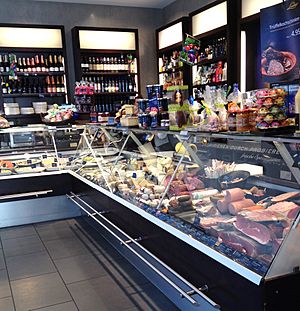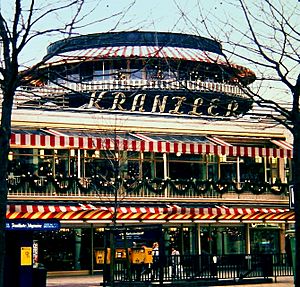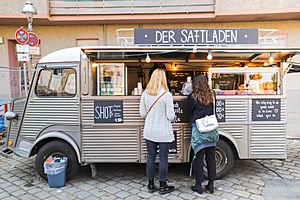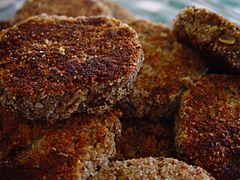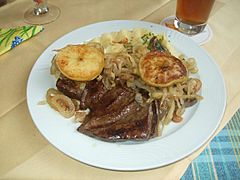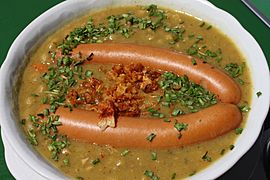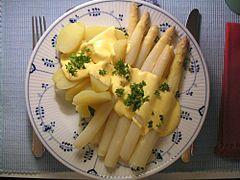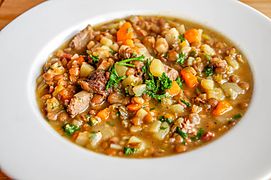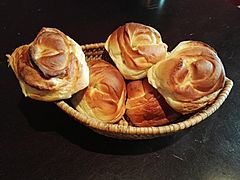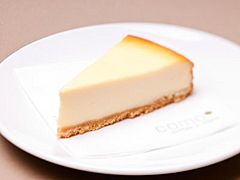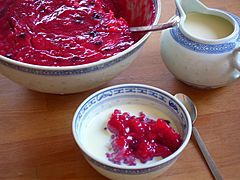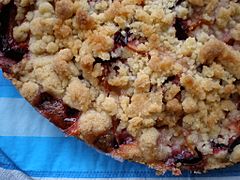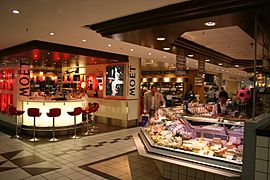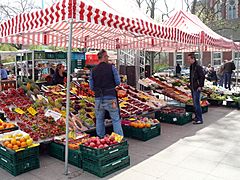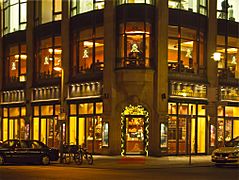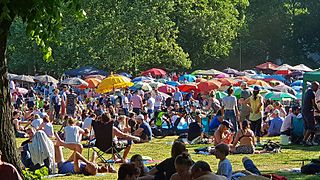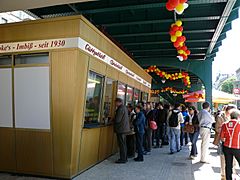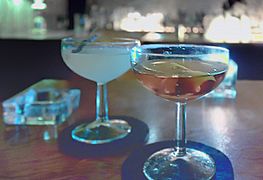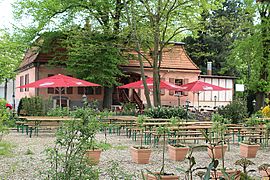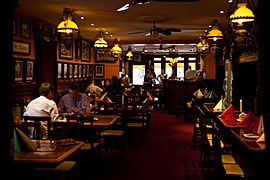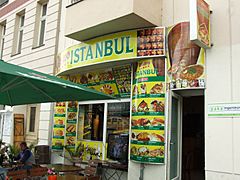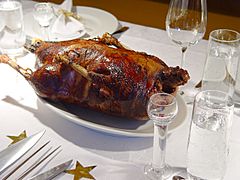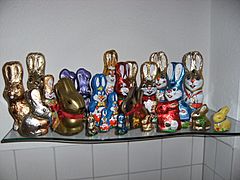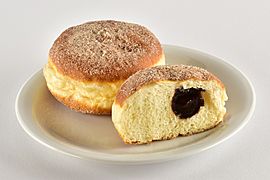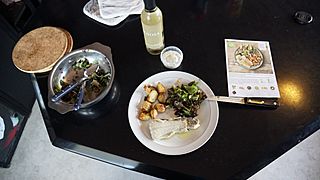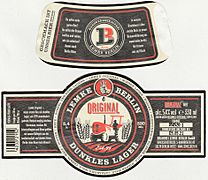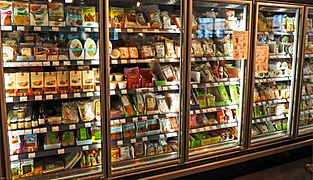Cuisine of Berlin facts for kids
The Cuisine of Berlin is all about the yummy food you can find in Germany's capital city, Berlin! It includes traditional German dishes that families in Berlin have cooked for ages. But it also has lots of simple, tasty pub food and snacks. Over time, Berlin's food scene has become super international. This is because many people from different countries have moved there since 1945 and 1990. After the year 2000, Berlin also became home to many fancy, top-notch restaurants.
Contents
History of Berlin's Food
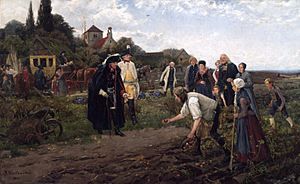
For a long time, until the late 1800s, Berlin's food was quite simple. It was all about hearty, filling meals rather than fancy ones. In the 1600s, many Huguenots (French Protestants) came to Berlin. They brought their own cooking styles with them. Berlin's cooking took some of these ideas but made them simpler.
Common ingredients back then included pork, goose, and fish like carp and eel. Vegetables like cabbage, peas, lentils, beans, beets, cucumbers, and potatoes were also very popular. Interestingly, people used to eat a lot of crayfish. This was because Berlin's waters had plenty of fish and crayfish in the 1700s and 1800s.
When Germany became an empire, Berlin grew into a big capital city. People from different parts of the country moved there, bringing new food traditions. This made Berlin's food more international. Jewish and Eastern European cooking styles were added, making the city's menu even bigger.
In the 1920s, Berlin was one of the world's largest cities. Many big hotels and restaurants offered all sorts of dishes. However, the Nazi rule and World War II stopped this amazing food variety. In East Berlin, fancy restaurants almost disappeared. For decades, there were hardly any international food influences. But in West Berlin, the restaurant scene slowly got better after the war.
The first fine dining restaurants opened in the rebuilt City West. Even during the time Berlin was divided by the Berlin Wall, the food department of KaDeWe was one of the biggest in the world. It is still a very popular place for both locals and tourists.
The famous Currywurst (curry sausage) is said to have been invented in 1949. A woman named Herta Heuwer from Königsberg created it. She ran a small snack stand in Charlottenburg.
In 1958, the Café Kranzler opened on Kurfürstendamm. It aimed to bring back the old coffeehouse culture from before the war. This café became a well-known spot in West Berlin.
After World War II, many workers from other countries came to Berlin. This made Berlin's food even more international. Turkish immigrants are believed to have invented the doner kebab in Kreuzberg in the 1970s. Today, it is one of Berlin's most famous snacks.
Since Germany became one country again in 1990, Berlin has become a top city for food lovers. Even in areas that were once in East Berlin, like Mitte or Prenzlauer Berg, you can now find many restaurants with food from all over the world.
Meal Times in Berlin
For breakfast, Berliners often eat bread rolls with jam, cold meats, or cheese. They usually drink coffee, tea, or juice with it. In the past, lunch was the biggest meal of the day. But now, many Berliners work longer hours and further from home. So, the main meal is often eaten in the evening instead.
Popular Berlin Dishes
Meat Dishes
- Liver Berlin style: This is fried veal liver with onions and apple slices. It's served with mashed potatoes.
- Currywurst: A grilled or boiled sausage cut into slices. It's topped with a special ketchup and curry powder.
- Kassler: This is salted and smoked roast pork.
- Roast goose: A traditional Christmas dinner in many Berlin homes.
- Königsberger Klopse: Meatballs made with anchovies and served in a caper sauce.
- Döner Kebab: Slices of seasoned meat cooked on a vertical spit. It's often served in a flatbread with salad and sauce.
- Buletten: These are German meatballs, usually made from ground meat and spices.
Fish Dishes
- Rollmops: These are pickled herring fillets rolled around a piece of pickled gherkin or onion.
- Polish carp: Carp fish cooked in a gingerbread sauce.
- Hecht mit Butterkartoffeln: Pike fish served with buttered potatoes.
-
Kartoffelpuffer with salmon and cream horseradish
Vegetable and Side Dishes
- Kartoffelpuffer: A potato pancake, often found at Christmas markets. It can be sweet with apple sauce and sugar, or savory with salmon and cream horseradish.
- Pellkartoffeln with quark and linseed oil: Boiled potatoes served with a fresh cheese and oil.
- Teltower Rübchen: A special type of small turnip. It's cooked in butter with caramelized sugar and served as a side dish.
- Sauerkraut: Fermented cabbage, a classic German side dish.
- Bratkartoffeln: Fried potatoes, often served as a side dish or a main meal with a fried egg.
- Asparagus with Hollandaise sauce: A popular spring dish, especially white asparagus.
- Linseneintopf: A type of lentil stew.
Sweet Treats
Desserts
- Berliner Luft: This means "Air of Berlin." It's a light white wine cream served with raspberry sauce.
- Mohnpielen: A type of Bread pudding made with poppy seeds.
- Rote Grütze: A red fruit jelly, often served with vanilla sauce or cream.
Bakery Products
- The Berliner or Berliner Pfannkuchen: A German doughnut, usually filled with jam.
- Berliner Napfkuchen: A yeast cake often with raisins.
- Berliner Käsekuchen: A cheese cake made from curd cheese with raisins and rum on a short pastry base.
- Liebesknochen: This means "Love Bone." It's the German word for an Éclair.
- Pflaumenkuchen mit Streuseln: Plum cake with streusel (crumbly topping).
- Splitterbrötchen: A type of crusty bread roll.
Markets and Food Shops
You can find German bakeries everywhere in Berlin. They offer a huge variety of breads and pastries. Europe's biggest market for special foods is at the KaDeWe department store. It has 34,000 different gourmet foods and drinks! One of the world's largest chocolate stores, Fassbender & Rausch, is also in Berlin.
Restaurants and Bars
Berlin has a huge variety of restaurants. This is because many immigrants have come to the city over the years. Turkish, Arab, Vietnamese, and many European people brought their food traditions with them. The modern fast-food version of the doner kebab sandwich was created in Berlin in the 1970s. It has become a favorite dish in Berlin and around the world! It's thought that there are over 1,000 Döner restaurants in Berlin alone. You can also find German pubs, Chinese, Thai, Indian, Korean, and Japanese restaurants. Plus, there are Spanish tapas bars, Italian, and Greek places all over the city.
In 2017, Berlin had seven restaurants that earned two Michelin stars. Another 14 restaurants received one star. This made Berlin the city with the most star restaurants in German-speaking countries that year! Berlin is also well-known for its many vegetarian and vegan restaurants. The city has a very creative food scene. It promotes global flavors, local ingredients, pop-up street food markets, and food festivals like Berlin Food Week.
Holiday Foods
On the Christmas Days after Christmas Eve, roasted goose is a very common meal. The Advent season (the weeks before Christmas) is often linked with sweet and spicy foods. These include Weihnachts- or Christstollen (a fruit bread) and Lebkuchen (gingerbread). The Easter season is usually connected with chocolate Easter eggs and Easter Bunnies. The time before Lent, known as the carnival season, and New Year's Eve are famous for Pfannkuchen (doughnuts).
-
Chocolate Easter Bunny
Food Companies and Brands
- August Storck: Makes candies like Toffifee, Knoppers, and Werther's Original.
- Bio Company: A chain of organic supermarkets.
- HelloFresh: A company that delivers meal kits.
- Delivery Hero: A global online food ordering and delivery service.
- Brauerei Lemke: A local brewery in Berlin.
- Veganz: A company that sells vegan food products.
See also
 In Spanish: Gastronomía de Berlín para niños
In Spanish: Gastronomía de Berlín para niños


